 THE
DAY THE EARTH STOOD STILL (1951)
THE
DAY THE EARTH STOOD STILL (1951) Director: Robert Wise
20th Century Fox
 THE
DAY THE EARTH STOOD STILL (1951)
THE
DAY THE EARTH STOOD STILL (1951) Like it or not. Agree or disagree. Hollywood has seen fit to remake yet another pivotal silver screen classic. While I personally find the thought of remaking or “reimagining” Robert Wise's milestone of science fiction cinema unmistakably unnecessary, I’m not so blinded by fanboy rage to overlook the silver lining. For each time a studio attempts to strike gold twice by updating a previous success, their marketing departments have wisely recognized a golden opportunity, one that not only helps to promote their latest release but also allows the studio to turn a profit on an already familiar and successful commodity. I am of course referring to the “Special Edition” double dip. Frequently street dating on the same week that the remake hits theaters, such releases often allow for the original and, more often than not, far superior version the opportunity to be re-mastered, repackaged and rediscovered. So the next time you see Keanu struggling to play an alien who has taken on human form (which really isn’t that big of a stretch for him), before you cringe in discontent, remember, at least the remake got Fox to release the original in a special edition.
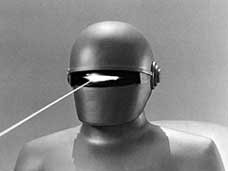
Based on short story by Harry Bates, THE DAY THE EARTH STOOD STILL stars Michael Rennie as Klaatu, an alien who has come to Earth to warn us of our self destructive nature and offer an ultimatum should we not immediately see the error of our ways. Traveling 250 million miles, Klaatu lands his flying saucer in Washington D.C. where he is greeted by a crowd of awestruck onlookers and heavily armed U.S. solders. Despite his assurances that his visit is in “peace and goodwill”, Klaatu is struck down by a nervous solider, instigating the wrath of the robotic giant Gort. Disintegrating every weapon the Army puts in front of it, the cyclopsed behemoth stands down only on the command of Klaatu, who leaves the colossus to guard the ship while he is taken away to a nearby hospital. All attempts by the U.S. government to uncover the purpose of Klaatu's unexpected visit are greeted with less than clear assurances, leaving Klaatu a prisoner for fear that his layover is a precursor to an all out invasion. Having conquered both time and space, Klaatu is not about to let a locked hospital door stand between him and his mission and breaks free of his confines, taking to the streets of D.C. Assuming the alias Mr. Carpenter, Klaatu acquires a room at a boarding home where he meets his neighbors Helen Benson (Patricia Neal) and her son Bobby (Billy Gray). Klaatu quickly finds favor with the mother and child, eventually confiding with Helen his true identity and intent. As the U.S. government and Helen’s beau (Hugh Marlowe) become increasingly agitated to the whereabouts and intentions of Klaatu, it falls in the hands of Helen and Professor Barnhardt (Sam Jaffe) to calm a frightened public and subdue the relentless destructive power of Gort before it’s too late.
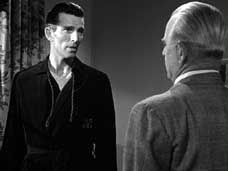 It
is hard to think of a director whose body of work is more eclectic than that
of Robert Wise. Having helmed pictures ranging from grand scale musicals (THE
SOUND OF MUSIC) and haunted house thrillers (THE HAUNTING) to rousing war narratives
(THE DESERT RATS) and science fiction franchises (STAR TREK:THE MOTION PICTURE),
Wise was equally comfortable in a variety of genres. His first cinematic work
was primarily in sound design but it was in his transition to editing that garnered
him both praise and attention, most notably for his work on Orson Welles’
CITIZEN KANE and THE MAGNIFICENT AMBERSONS, as well as William Dieterle’s
THE DEVIL AND DANIEL WEBSTER. No stranger to directing B-movie material, having
shot THE CURSE OF THE CAT PEOPLE and THE BODY SNATCHER for producer Val Lewton,
Wise saw a unique opportunity when initially approached by Darryl F. Zanuck
to direct THE DAY THE EARTH STOOD STILL. Attracted by the anti-war message,
Wise wholeheartedly agreed with the film's tale of caution in a burgeoning atomic
age. However equally compelling to Wise was the script’s take on aliens
and UFOs, as he was a firm believer in extraterrestrials and was eager to present
such material in a way that was sensational without being patronizing to the
audience. Wise succeeded masterfully in such a respect, directing a simple yet
sophisticated picture that has become a definitive classic of the science fiction
genre.
It
is hard to think of a director whose body of work is more eclectic than that
of Robert Wise. Having helmed pictures ranging from grand scale musicals (THE
SOUND OF MUSIC) and haunted house thrillers (THE HAUNTING) to rousing war narratives
(THE DESERT RATS) and science fiction franchises (STAR TREK:THE MOTION PICTURE),
Wise was equally comfortable in a variety of genres. His first cinematic work
was primarily in sound design but it was in his transition to editing that garnered
him both praise and attention, most notably for his work on Orson Welles’
CITIZEN KANE and THE MAGNIFICENT AMBERSONS, as well as William Dieterle’s
THE DEVIL AND DANIEL WEBSTER. No stranger to directing B-movie material, having
shot THE CURSE OF THE CAT PEOPLE and THE BODY SNATCHER for producer Val Lewton,
Wise saw a unique opportunity when initially approached by Darryl F. Zanuck
to direct THE DAY THE EARTH STOOD STILL. Attracted by the anti-war message,
Wise wholeheartedly agreed with the film's tale of caution in a burgeoning atomic
age. However equally compelling to Wise was the script’s take on aliens
and UFOs, as he was a firm believer in extraterrestrials and was eager to present
such material in a way that was sensational without being patronizing to the
audience. Wise succeeded masterfully in such a respect, directing a simple yet
sophisticated picture that has become a definitive classic of the science fiction
genre.
 Originally
released on DVD as part of its “Studio Classics” line in early 2003,
20th Century Fox's two disc special edition is a commendable effort that exhaustively
covers the film and its participants, most notably Bernard Herrmann, but falls
short of being a definite effort thanks in part to its failure to roll over all
previously commissioned special features. Offered on a dual, single layer disc,
the film is presented full frame in a 1.33:1 aspect ratio. While there is at times
a fine grain on the transfer, you really have to nitpick to find anything to complain
about in regards to picture quality. Blacks are deep and detail is sharp, allowing
one to examine every pore in Michael Rennie's chiseled face, that is if you’re
into that sort of thing. While such clarity does point out a number of the film's
technical flaws, such as Gort’s knees which bend like a paper towel roll,
it also highlights the dramatic and highly effective matte work and animation
used to create the flying saucers' initial arrival and descent. Audio is as clear
as bell and is available in both an English mono and 5.1 Dolby surround track.
Spanish and French mono audio tracks can also be accessed through the disc's “Language
Selection” screen, as are English and Spanish subtitles.
Originally
released on DVD as part of its “Studio Classics” line in early 2003,
20th Century Fox's two disc special edition is a commendable effort that exhaustively
covers the film and its participants, most notably Bernard Herrmann, but falls
short of being a definite effort thanks in part to its failure to roll over all
previously commissioned special features. Offered on a dual, single layer disc,
the film is presented full frame in a 1.33:1 aspect ratio. While there is at times
a fine grain on the transfer, you really have to nitpick to find anything to complain
about in regards to picture quality. Blacks are deep and detail is sharp, allowing
one to examine every pore in Michael Rennie's chiseled face, that is if you’re
into that sort of thing. While such clarity does point out a number of the film's
technical flaws, such as Gort’s knees which bend like a paper towel roll,
it also highlights the dramatic and highly effective matte work and animation
used to create the flying saucers' initial arrival and descent. Audio is as clear
as bell and is available in both an English mono and 5.1 Dolby surround track.
Spanish and French mono audio tracks can also be accessed through the disc's “Language
Selection” screen, as are English and Spanish subtitles.
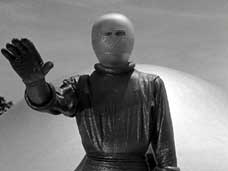 Disc
One’s special features include two audio commentary tracks, the first
a carry-over form Fox’s previous DVD release. Recorded before his death
in 2005, director Robert Wise is guided through a commentary track by filmmaker
Nicholas Meyer (STAR TREK: THE WRATH OF KHAN) that delves into the film's development
and key players. Wise confirms that the film's religious similarities to the
life of Jesus Christ were oblivious to him at the time of filming, only finding
about such connotations years after the original theatrical release. An all
new commentary track featuring film and music historians John Morgan, Steven
Smith William Stromberg and Nick Redman focuses primarily on Bernard Herrmann,
so much so that it isn’t until the film's half way mark that the group
of men begin to discuss any of the other crew or cast members. No doubt their
favorite feature of this release is an isolated music track, which allows you
to watch the film sans dialogue, letting every subtle nuance of Herrmann score
shine bright. “The Making of The Day the Earth Stood Still” is a
24-minute documentary that covers Robert Wise’s carrier rather efficiently
before probing into the film's effects work and memorable score. While this
supplement covers a lot of ground in a short period of time, offering several
interesting bits of trivia, such as Spencer Tracy originally being offered the
role of Klaatu, it should be noted that this “Making of” feature
is unique to this release and, while entertaining, seems humble next to the
similar yet more expansive, 70 minute doc found on Fox Studios' previous DVD
release. “The Mysterious Melodious Theremin" is a brief 6 minute
history on the electronic musical device that Bernard Herrmann used (actually
he used two) to help create DAY’s distinctive otherworldly score. An odd
looking apparatus, the Theremin resembles an old talk radio with two thin rounded
poles protruding from either end. Peter Pringle, who narrates the Theremin feature,
plays the film's main theme in a live performance also available in Disc One's
special features. Having seen a Theremin performed live (at a Jon Spencer Blues
Explosion concert) I can tell you from experience that it obviously takes a
great deal of talent and practice to conjure up anything remotely resembling
a melody from the peculiar device.
Disc
One’s special features include two audio commentary tracks, the first
a carry-over form Fox’s previous DVD release. Recorded before his death
in 2005, director Robert Wise is guided through a commentary track by filmmaker
Nicholas Meyer (STAR TREK: THE WRATH OF KHAN) that delves into the film's development
and key players. Wise confirms that the film's religious similarities to the
life of Jesus Christ were oblivious to him at the time of filming, only finding
about such connotations years after the original theatrical release. An all
new commentary track featuring film and music historians John Morgan, Steven
Smith William Stromberg and Nick Redman focuses primarily on Bernard Herrmann,
so much so that it isn’t until the film's half way mark that the group
of men begin to discuss any of the other crew or cast members. No doubt their
favorite feature of this release is an isolated music track, which allows you
to watch the film sans dialogue, letting every subtle nuance of Herrmann score
shine bright. “The Making of The Day the Earth Stood Still” is a
24-minute documentary that covers Robert Wise’s carrier rather efficiently
before probing into the film's effects work and memorable score. While this
supplement covers a lot of ground in a short period of time, offering several
interesting bits of trivia, such as Spencer Tracy originally being offered the
role of Klaatu, it should be noted that this “Making of” feature
is unique to this release and, while entertaining, seems humble next to the
similar yet more expansive, 70 minute doc found on Fox Studios' previous DVD
release. “The Mysterious Melodious Theremin" is a brief 6 minute
history on the electronic musical device that Bernard Herrmann used (actually
he used two) to help create DAY’s distinctive otherworldly score. An odd
looking apparatus, the Theremin resembles an old talk radio with two thin rounded
poles protruding from either end. Peter Pringle, who narrates the Theremin feature,
plays the film's main theme in a live performance also available in Disc One's
special features. Having seen a Theremin performed live (at a Jon Spencer Blues
Explosion concert) I can tell you from experience that it obviously takes a
great deal of talent and practice to conjure up anything remotely resembling
a melody from the peculiar device.
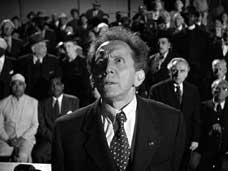
Continuing Disc One's expansive coverage of the film's source material, Jamieson K. Price reads “Farewell to the Master” in three parts, allowing an appropriate comparison to the film and the short story from which it was based. Originally appearing in “Astounding Science Fiction”, Harry Bates' short story strongly differs from the theatrical version, most outstandingly in that Klaatu was not the one calling the shots, the robot was. A Fox Movietonews from 1951 is also included and shows but a brief snippet of a man dressed as Klaatu accepting a science fiction convention award. Teaser and theatrical trailers are included as well as a theatrical trailer for the 2008 remake. An extended look at the Scott Derrickson (THE EXORCISM OF EMILY ROSE) remake proceeds Disc One's main menu, displaying a much more effects-laden production than the source material.
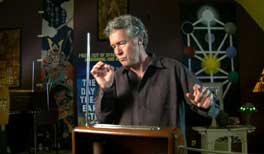 The
second disc of 20th Century Fox’s special edition is broken into two sections,
featurettes and galleries. “Decoding “Klaatu Barada Nikto”:
Science Fiction as Metaphor” is a 16 minute documentary that explores
the film's place in history as it pertains to the world climate at the time.
With the cold war at the forefront of every American's mind, the filmmakers
had plenty of real fears to draw upon, bringing a sense of realism to a decidedly
sci-fi plot. “A brief History of Flying Saucers” covers the usual
suspects (Roswell) as well a few other lesser known encounters in a 34 minute
documentary that doesn’t add a lot to the already heated debate about
UFOs, but does manage to entertain and help place the film within the proper
flying disc hysteria of its time. “The Astounding Harry Bates" is
an 11 minute featurette that explore the life and literary work of the author
who would concoct the seed that would grow to become THE DAY THE EARTH STOOD
STILL. Most surprising is the revelation of Harry’s disapproval of the
science fiction genre, particularly considering he was so accomplished at writing
within it. Covering his career in about 15 minutes, “Edmund North: The
Man Who Made the Earth Stand Still” lays out through interviews with family
and critics the impressive life and work of the staunch anti-war supporter,
who ironically found critical acclaim for his epic war scripts, winning the
academy award in 1971 for his rewrite of PATTON. Book-ending a meticulous array
of special features is the inclusion of RACE TO OBLIVION, a public service announcement
commissioned by the Los Angeles chapter of the Physicians for Social Responsibility
that was written by North and stars Burt Lancaster. Switching over to the extensive
galleries menu allows you to browse through advertising, behind-the-scenes stills,
and portrait and production galleries. You can also access spaceship construction
blueprints and the film's original shooting script, but most impressive is an
interactive option that allows you to browse through the film's imaginative
pressbook. Sections of the pressbook can be highlighted, allowing you to view
a variety of areas close-up and in stunning detail.
The
second disc of 20th Century Fox’s special edition is broken into two sections,
featurettes and galleries. “Decoding “Klaatu Barada Nikto”:
Science Fiction as Metaphor” is a 16 minute documentary that explores
the film's place in history as it pertains to the world climate at the time.
With the cold war at the forefront of every American's mind, the filmmakers
had plenty of real fears to draw upon, bringing a sense of realism to a decidedly
sci-fi plot. “A brief History of Flying Saucers” covers the usual
suspects (Roswell) as well a few other lesser known encounters in a 34 minute
documentary that doesn’t add a lot to the already heated debate about
UFOs, but does manage to entertain and help place the film within the proper
flying disc hysteria of its time. “The Astounding Harry Bates" is
an 11 minute featurette that explore the life and literary work of the author
who would concoct the seed that would grow to become THE DAY THE EARTH STOOD
STILL. Most surprising is the revelation of Harry’s disapproval of the
science fiction genre, particularly considering he was so accomplished at writing
within it. Covering his career in about 15 minutes, “Edmund North: The
Man Who Made the Earth Stand Still” lays out through interviews with family
and critics the impressive life and work of the staunch anti-war supporter,
who ironically found critical acclaim for his epic war scripts, winning the
academy award in 1971 for his rewrite of PATTON. Book-ending a meticulous array
of special features is the inclusion of RACE TO OBLIVION, a public service announcement
commissioned by the Los Angeles chapter of the Physicians for Social Responsibility
that was written by North and stars Burt Lancaster. Switching over to the extensive
galleries menu allows you to browse through advertising, behind-the-scenes stills,
and portrait and production galleries. You can also access spaceship construction
blueprints and the film's original shooting script, but most impressive is an
interactive option that allows you to browse through the film's imaginative
pressbook. Sections of the pressbook can be highlighted, allowing you to view
a variety of areas close-up and in stunning detail.
While the exclusion of the 70 minute documentary available on its previous DVD release may prevent many from labeling this “Special Edition” (which is also available on Blu-ray) as definitive, the vast range of extras and the quality of its presentation definitely make it a recommended buy, particularly if you don’t already own its previous DVD or laserdisc releases. (Jason McElreath)